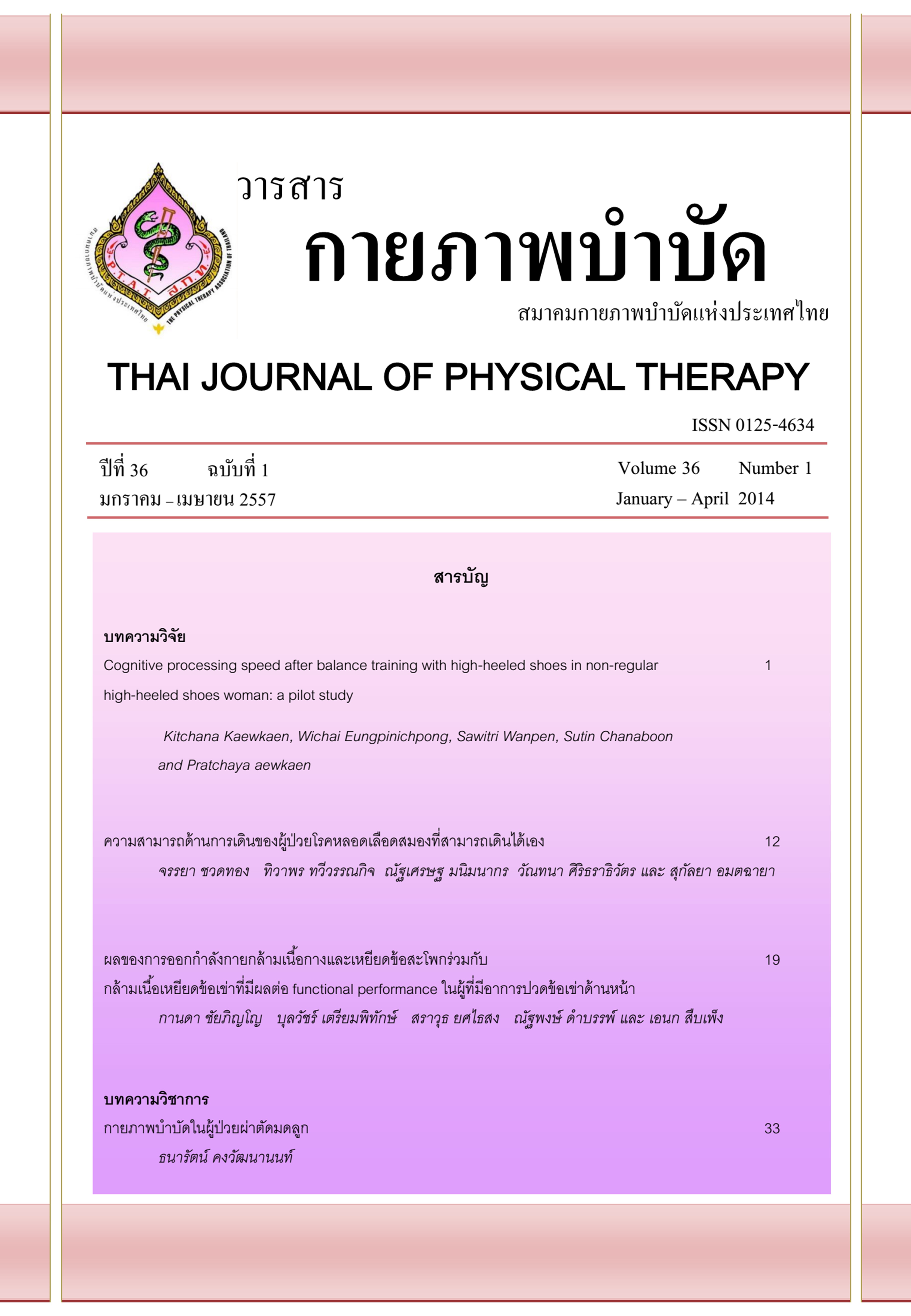ผลของการออกกำลังกายกล้ามเนื้อกางและเหยียดข้อสะโพกร่วมกับกล้ามเนื้อเหยียดข้อเข่าที่มีผลต่อ functional performance ในผู้ที่มีอาการปวดข้อเข่าด้านหน้า
Main Article Content
บทคัดย่อ
บทนำ: การรักษาหลักสำหรับอาการปวดข้อเข่าด้านหน้าคือการออกกำลังกายกล้ามเนื้อข้อเข่าและข้อสะโพก เพื่อลดอาการปวดเข่า และเพิ่มความสามารถในการเคลื่อนไหว แต่งานวิจัยที่ผ่านมายังไม่มีข้อสรุปที่ชัดเจนว่าการออกกำลังกายข้อสะโพกพร้อมกับข้อเข่าจะให้ผลดีกว่าการออกกำลังกายข้อเข่าอย่างเดียวอย่างไร
วัตถุประสงค์: เพื่อเปรียบเทียบผลของการออกกำลังกายกล้ามเนื้อกางและเหยียดข้อสะโพกร่วมกับกล้ามเนื้อเหยียดข้อเข่า (HKE) ใน closed kinetic chainเปรียบเทียบกับการออกกำลังกายกล้ามเนื้อเหยียดข้อเข่าเพียงอย่างเดียว (KE) ต่ออาการปวดและความสามารถในการเคลื่อนไหวในผู้ที่ปวดเข่าด้านหน้า
วิธีดำเนินงานวิจัย: ผู้เข้าร่วมการวิจัยเป็นผู้มีอาการปวดข้อเข่าทางด้านหน้ามาอย่างน้อย 4 สัปดาห์ ประเมินอาการปวดและความสามารถในการเคลื่อนไหวโดยใช้ Kujala's Anterior Knee Pain Score (KAKPS) และทดสอบในท่า Step down test (SDT) และ Single leg squat (SLS) โดยประเมินระดับความเจ็บปวด(VAS) ขณะทดสอบและจำนวนครั้งที่สามารถทำได้ในเวลา 30 วินาที สุ่มผู้เข้าร่วมการวิจัยเป็น 3 กลุ่ม คือกลุ่มที่ออกกำลังกายข้อสะโพกพร้อมกับข้อเข่า (Hip & Knee exercise, HKE) กลุ่มที่ออกกำลังข้อเข่าอย่างเดียว (Knee exercise, KE) และกลุ่มควบคุม (Control) ตามลำดับโดยออกกำลังกาย10 ครั้ง/เซต 3 เซต/วัน 5 วัน/สัปดาห์เป็นเวลา 4 สัปดาห์ ประเมิน KAKPS, SDT และ SLS ทุกสัปดาห์ วิเคราะห์ผลทางสถิติโดยใช้ค่าความแตกต่างของสัปดาห์ที่ 4 กับตอนเริ่มต้นในการเปรียบเทียบผลระหว่าง 3 กลุ่ม โดยใช้สถิติ One way-ANOVA ที่ p<.05
ผลการวิจัย : ผู้เข้าร่วมการวิจัย 22 คน (หญิง 18 คนและชาย 4 คนอายุ 19-22 ปี BMI 20.9+4.8 Kg/m2) ไม่มีความแตกต่างระหว่างกลุ่มของค่าตัวแปรที่วัดก่อนการทดสอบ ผลการเปรียบเทียบหลังการออกกำลังกายระหว่างกลุ่มพบว่ากลุ่ม HKE และกลุ่ม KE มีการเพิ่มขึ้นของ KAKPS (HKE =16.9+5.6, KE=13.5+ 8.7) มากกว่ากลุ่มควบคุม (4.6+ 5.5, p<.05) แต่ไม่พบความแตกต่างของกลุ่ม HKE กับกลุ่ม KE และพบว่ากลุ่ม HKE มีระดับความปวดขณะทำ SDT ลดลง (2.8+1.6) มากกว่ากลุ่ม KE (1.2+1.4) และมากกว่ากลุ่มควบคุม (1.3+ 1.4)แต่ไม่พบว่ามีความแตกต่างระหว่างกลุ่มเมื่อประเมินจากจำนวนครั้งที่ทำ SDT และ SLS เช่นเดียวกับระดับความปวดขณะทำ SLS ที่ไม่พบแตกต่างระหว่างกลุ่ม
สรุปผลการวิจัย: การออกกำลังกายกล้ามเนื้อเหยียดและกางข้อสะโพกร่วมกับกล้ามเนื้อเหยียดข้อเข่าเพิ่มความสามารถในการเคลื่อนไหวขณะทำ SDT ได้ดีกว่าเมื่อประเมินด้วย KAKPS และลดอาการปวดขณะก้าวลงบันไดได้มากกว่าการออกกำลังกายข้อเข่าอย่างเดียว แต่จำนวนครั้งที่สามารถทำ SDT และ SLS ไม่แตกต่างกัน
Article Details
เอกสารอ้างอิง
2. Nakagawa TH, Moriya ET, Maciel CD, Serrao FV. Trunk, pelvis, hip, and knee kinematics, hip strength, and gluteal muscle activation during a single-leg squat in males and females with and without patellofemoral pain syndrome. J Orthop Sports Phys Ther 2012;42:491-501.
3. Wilson T. The measurement of patellar alignment in patellofemoral pain syndrome: are we confusing assumptions with evidence? J Orthop Sports Phys Ther 2007; 37:330-41.
4. Waryasz GR, McDermott AY. Patellofemoral pain syndrome (PFPS): A systematic review of anatomy and potential risk factors. DM 2008; 7:9. doi:10.1186/1476-5918-7-9.
5. Witvrouw E, Lysens R, Bellemans J, Cambier D, Vanderstraeten G. Intrinsic risk factors for the development of anterior knee pain in an athletic population. A two-year prospective study. Am J Sports Med 2000; 28:480-9.
6. Nakagawa TH, Serrao FV, Maciel CD, Powers CM. Hip and knee kinematics are associated with pain and self-reported functional status in males and females with patellofemoral pain. Int J Sports Med 2013;34:997-1002.
7. Powers CM. The influence of altered lower-extremity kinematics on patellofemoral joint dysfunction: A theoretical perspective. J Orthop Sports Phys Ther2003;33:639-46.
8. Powers CM. The influence of abnormal hip mechanics on knee injury: a biomechanical perspective. J Orthop Sports Phys Ther 2010; 40:42-51.
9. Perry J. Gait analysis: normal and pathological function. Thorofare, NJ: Slack Inc.; 1992. p.53, 91, 113, 432.
10. Minoonejad H, Rajabi R, Ebrahimi-Takamjani E, Alizadeh MH, Jamshidi AA, Azhari A, et al. Combined open and closed kinetic chain exercises for patellofemoral pain syndrome: A randomized controlled trial. World J of Sport Sci 2012;6: 278-85.
11. Witvrouw E, Lysens R, Bellemans J, Peers K, Vanderstraeten G. Open versus closed kinetic chain exercises for patellofemoral pain. A prospective, randomized study. Am J Sports Med2000;28:687-94.
12. Bennell K, Duncan M, Cowan S, McConnell J, Hodges P, Crossley K. Effects of vastus medialis oblique retraining versus general quadriceps strengthening on vasti onset. Med Sci Sports Exerc2010;42: 856-64.
13. Chaudhari LD, Rao K. Effectiveness of general quadriceps strengthening versus selective vastus medialis obliquus strengthening in patellofemoral pain syndrome. IJBAMR 2011; 1: 71-6.
14. Grelsamer RP, McConnell J. The patella: a team approach. Gaithersburg, Maryland, Aspen Publishers, Inc., 1998:129.
15. Barton CJ, Kennedy A, Twycross-Lewis R, Woledge R, Malliaras P, Morrissey D. Gluteal muscle activation during the isometric phase of squatting exercises with and without a Swiss ball. Phys Ther Sport 2014; 15:39-46.
16. Herrington L, Al-Sherhi A. A controlled trial of weight-bearing versus non-weight-bearing exercises for patellofemoral pain. J Orthop Sports Phys Ther 2007; 37:155-60.
17. Witvrouw E, Danneels L, Van Tiggelen D, Willems TM, Cambier D. Open versus closed kinetic chain exercises in patellofemoral pain: A 5-year prospective randomized study. Am J Sports Med2004; 32:1122-30.
18. Gryzlo SM, Patek RM, Pink M, Perry J. Electromyographic analysis of knee rehabilitation exercises. J Orthop Sports Phys Ther 1994; 20: 36-43.
19. Nakagawa TH, Muniz TB, Baldon Rde M, Dias Maciel C, de Menezes Reiff RB, Serrao FV. The effect of additional strengthening of hip abductor and lateral rotator muscles in patellofemoral pain syndrome: A randomized controlled pilot study. Clin Rehabil 2008; 22:1051-60.
20. Dolak KL, Silkman C, Medina McKeon J, Hosey RG, Lattermann C, Uhl TL. Hip strengthening prior to functional exercises reduces pain sooner than quadriceps strengthening in females with patellofemoral pain syndrome: A randomized clinical trial. J Orthop Sports Phys Ther 2011; 41:560-70.
21. Fukuda TY, Rossetto FM, Magalhaes E, Bryk FF, Lucareli PR, de Almeida Aparecida Carvalho N. Short-term effects of hip abductors and lateral rotators strengthening in females with patellofemoral pain syndrome: A randomized controlled clinical trial. J Orthop Sports Phys Ther 2010;40: 736-42.
22. Dilokpongrawee P, Sudkrasare T, Janmanee S, Chaipinyo K. Functional performance test and Kujala's anterior knee pain scale in participants with anterior knee pain compared to controls. 4th year student research project. Faculty of Health Science, Srinakharinwirot University 2012 (unpublished).
23. Kujala UM, Jaakkola LH, Koskinen SK, Taimela S, Hurme M, Nelimarkka O. Scoring of patellofemoral disorders. Arthroscopy 1993; 9:159-63.
24. Loudon JK, Wiesner D, Goist-Foley HL, Asjes C, Loudon KL. Intrarater reliability of functional performance tests for subjects with patellofemoral pain syndrome. J Athl Train 2002; 37:256-61.
25. Fukuda TY, Melo WP, Zaffalon BM, Rossetto FM, Magalhaes E, Bryk FF, et al. Hip posterolateral musculature strengthening in sedentary women with patellofemoral pain syndrome: A randomized controlled clinical trial with 1-year follow-up. J Orthop Sports Phys Ther 2012; 42:823-30.
26. Bennell K, Bartam S, Crossley K, Green S. Outcome measures in patellofemoral pain syndrome: Test retest reliability and inter-relationships. Phys Ther Sport 2000; 1:32-41.
27. Watson C, Propps M, Ratner J, Zeigler DL, Horton P, Smith SS. Reliability and responsiveness of the lower extremity functional scale and the anterior knee pain scale in patients with anterior knee pain. J Orthop Sports Phys Ther 2005;35: 136-46.


